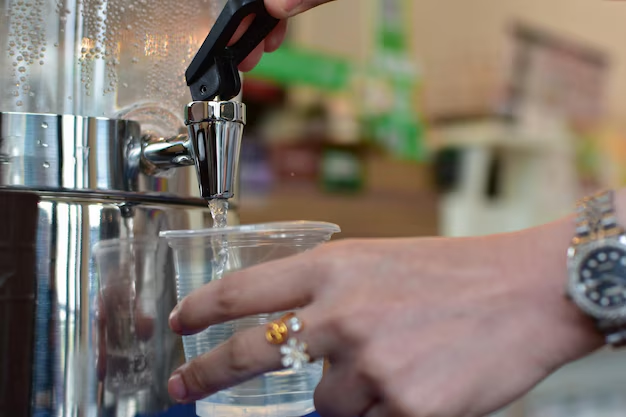Why Is Your Refrigerator Water Dispenser Running Slow? Let's Dive In!
There's nothing as refreshing as a cold glass of water straight from your refrigerator's water dispenser. However, when that refreshing flow turns into a frustrating trickle, it might leave you wondering, "Why is my refrigerator water dispenser so slow?" Understanding the dynamics of your refrigerator's water dispenser can not only restore its efficiency but also save you time and effort. Here, we'll explore various potential causes of a sluggish dispenser and offer practical, implementable solutions to get it back up to speed.
🛠 Understanding the Basics of Water Flow
Before diving into problem-solving, understanding how your refrigerator water dispenser works can provide valuable insights:
- Water Supply Line: This line connects your refrigerator to the house water supply, delivering water to the dispenser and the ice maker.
- Water Filter: The filter removes impurities from the water, ensuring a clean and fresh taste.
- Water Inlet Valve: This valve controls the flow of water into the refrigerator.
- Dispenser Mechanism: Located on your fridge door, this mechanism dispenses water when activated.
Common Causes and Solutions for Slow Water Dispensing
🚰 Blockages and Restrictions in the Water Line
Over time, water lines can develop blockages due to mineral deposits or freezing, reducing the water flow.
How to Check:
- Inspect the water line for visible kinks or bends.
- Detach the water line and look for blockages.
Solution:
- Heat: If frozen, use a hairdryer to melt away ice blockages.
- Replace: For mineral build-up, disassemble and clean or replace the water line.
🧊 Freezing in Water Reservoir
If your fridge is set to a very low temperature, it could cause the water reservoir to freeze.
How to Check:
- Feel for cold spots around your dispenser area.
- Inspect the reservoir for frost buildup.
Solution:
- Adjust Temperature: Set your fridge temperature slightly higher to avoid freezing.
- Defrost: Disconnect the fridge and allow the reservoir to defrost naturally.
🚿 Clogged Water Filter
A water filter performs the crucial task of purifying your water. But, like any filter, it can become clogged and hinder water flow.
How to Check:
- Check the manufacturer's manual for filter location and replacement indications.
Solution:
- Regular Replacement: Replace the filter every six months or as recommended. This maintains optimal water flow and purity.
🔧 Faulty Water Inlet Valve
A malfunctioning water inlet valve can significantly slow down water distribution.
How to Check:
- Listen for the valve opening sound when the dispenser is activated.
- Use a multimeter to ensure electrical functionality.
Solution:
- Repair or Replace: Consult a professional for valve assessment and replacement if necessary.
🏡 Household Water Pressure
Water pressure plays a pivotal role in the performance of your refrigerator dispenser.
How to Check:
- Consult your water supply professional to measure household water pressure.
Solution:
- Adjust Pressure: Consider installing a booster pump if the pressure is below the recommended level.
🤔 Less Common Issues to Consider
🪛 Malfunctioning Dispenser Switch
The dispenser switch might be worn out or faulty, inhibiting the activation of the water flow.
Solution:
- Inspect and Test: Check for continuity with a multimeter and replace it if needed.
⚙️ Air Trapped in Water Line
Bubbles and air pockets can disrupt the water flow.
Solution:
- Bleed the Line: Run the water dispenser for a few minutes to remove trapped air.
🛡 Manufacturer Defects
Occasionally, manufacturing defects in the refrigerator may cause continuous issues with the dispenser.
Solution:
- Seek Professional Help: If troubleshooting doesn't resolve the issue, professional service or contacting the manufacturer may be necessary for a warranty claim.
📝 Handy Summary: Quick Takeaways
Here are some quick tips and takeaways to keep your water dispenser running smoothly:
- 🔄 Replace water filters every six months.
- 🌡 Adjust fridge temperature to prevent freezing in the reservoir.
- 🚿 Check water lines for blockages or kinks.
- 🔧 Ensure household water pressure is at an optimum level.
- 🌬 Run the dispenser regularly to release any trapped air.
Insights: Keeping It Flowing
The journey in resolving a slow water dispenser is fundamentally about understanding the interconnected system within your refrigerator and your home. Regular maintenance checks and an awareness of operational norms can go a long way in preventing future disruptions.
In your pursuit of optimal water flow, remember that each component plays a part, and sometimes the solution can be as simple as changing a filter or adjusting a temperature setting. By staying proactive with these insights and tips, you can ensure that your fridge's water dispenser provides you with a consistent and refreshing flow.
Retracing the path of water from your supply line to your glass reveals that a lot can happen in that space, but armed with the right information, you'll always stay ahead and fix the slowness. Keep these strategies in mind, and you'll maintain a well-functioning refrigerator that enhances both convenience and lifestyle.
